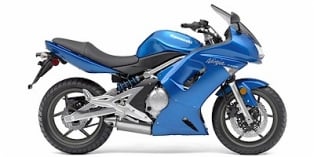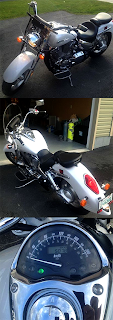| It’s been ice-storm icy here |
Without warm weather beckoning (we’ve been in the middle of an ice-storm here) I’m in less of a panic about not having a bike to ride. With an extended long weekend thanks to power failures and such, I’ve been hammering through four carb rebuilds.
The K&L kit I got came with a new bowl gasket, new pilot jet, washer and o-ring, and a new float jet. Breaking down each carburetor one at a time (so I don’t mix up parts), I cleaned out the carbs and blew them out with compressed air and then put them back together with the new parts.
| Those little rubber bits get crusty after 22 years on a bike… |
Adjustment wise I reset the float height (17mms with the float unweighted – held sideways). I also reset the pilot jets to two turns out from snug. The pilot jets varied from almost five turns out to under three turns out. I’m curious to see how this affects fueling. The manual suggested resetting them to what they were, and I did record them, but the factory setting is 2 turns from snug, so that’s what I reset them to. I’m not sure why I’d reset them to what they were when they weren’t working well.
The carb rebuilds weren’t particularly difficult, but they were a bit tedious (you’re basically doing the same thing four times). Things have ground to a halt again as I’ve found that I need o-rings to replace the old, broken ones that sealed the fuel lines between carbs. With some new o-rings I should be good to put them all back together again and re-vacuum tube them with new tubing.
As an aside, I thought it would be a good idea to go through Motorcyclesuperstore.ca, but they seem to have pulled back from offering Canadian customers a clear view of their prices. You used to be able to buy in Canadian dollars and there were no surprises. When you buy now they charge in U$D, so you’ve got to do some math to figure out how they compare to Canadian retailers. It looked like they came out about twenty bucks ahead of an equivalent Canadian order, until I got the COD message with border taxes. Suddenly that twenty bucks turned into paying an extra ten. I liked motorcyclesuperstore.com, their customer service went above and beyond, but their lack of clarity around pricing of orders to Canada puts them in the same category as any other US distributor. I’m not happy with canadasmotorcycle.ca’s ‘easy’ returns (they charge you for shipping), but I’m not playing roulette with customs costs again. I’m afraid that’s the last time I’ll use motorcyclesuperstore. I need to start looking into other Canadian based motorcycle retailers.
| Two down, two to go… |
| The pilot jet (centre) – has a spring, washer and o-ring underneath. |
| The float bowl off and being cleaned out – the floats are held in a pin at the bottom – the float jet hooks on a tab in the middle |
Carb Photos:
https://goo.gl/photos/kPhLXuQnb8HmdQFs9
























































